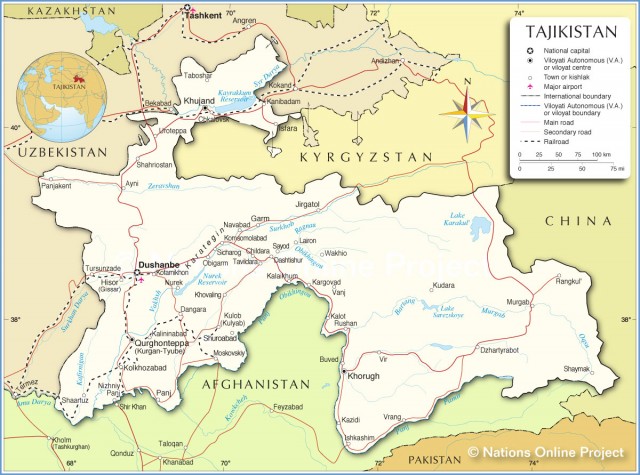Tajikistan
Area 55,251 square mi (143,100 square km)
Population 8.296 million 2014
Capital Dushanbe
Highest Point 24,591 ft (7,495 m)
Lowest Point 984 ft (300 m)
GDP $9.242 billion 2014
Primary Natural Resources hydropower, uranium, mercury.
LANDLOCKED AND MOUNTAINOUS, Tajikistan gained its independence in 1991 following the dissolution of the Soviet Union. The Republic of Tajikistan was engulfed in a bloody civil war from 1992 to 1997 and today continues to suffer grinding poverty. Tajikistan is the smallest country in Central Asia, bordering AFGHANISTAN to the south, UZBEKISTAN to the west and northwest, KYRGYZSTAN to the north, and CHINA to the east.

Tajikistan is primarily a mountainous country, dominated by the Trans-Alay and Pamir ranges. A full 93 percent of Tajikistan's land area is covered by mountains, with just 5 percent suitable for agricultural production. Notable valleys include the Ferghana Valley in the west, and the Kofarnihan and Vakhsh valleys in the southwest. Tajikistan is home to some of Central Asia's highest mountains, including Pik Lenina (23,400 ft or 7,134 m) and Pik Kommunizma (24,580 ft or 7,495 m). Tajikistan's small size limits the variety of its natural resource base, although hydropower, uranium, zinc, and gold play important roles in the Tajik economy. Tajikistan's climate is classified as midlatitude continental, ranging from polar in the mountains, to semiarid in the Ferghana Valley.
Tajikistan's population distribution is centered on its capital city of Dushanbe with an additional cluster in the heavily populated Ferghana Valley. Unlike other Central Asian neighbors, Tajiks are of Persian rather than Turkic descent. The ethnic mix in Tajikistan includes Tajik (65 percent of the population), Uzbek (25 percent), and Russian (3.5 percent) peoples. While the official language is Tajik, Russian remains the language of government, business, and interethnic communication. As in other Central Asian states, ISLAM is the dominant religion in Tajikistan, practiced by 90 percent of the population. The country's economy is beset by poverty and unemployment.
The country's per capita gross domestic product (GDP) is lowest of all 15 former republics of the Soviet Union and ranks just above MALI and just below BURKINA FASO, two of Africa's poorest countries. The fiveyear civil war of the 1990s severely damaged vital infrastructure and kept foreign investment at bay. Sixty percent of Tajikistan's population lives below the poverty line, and the unemployment rate is an astounding 40 percent. Employment in Tajikistan is dominated by the primary sector, with agriculture employing 67 percent of the labor force. Even the industrial sector, employing 7.5 percent of the labor force, is largely primary-based, involving the processing of aluminum, zinc, and lead. Agricultural products include cotton, grain, cattle, sheep, and goats. Additional economic concerns for Tajikistan include uneven structural reforms and burdensome external debt obligations.
Perhaps the most pressing geopolitical issue facing Tajikistan is its northwest border with both Uzbekistan and Kyrgyzstan. In this area, seemingly randomly drawn boundaries divide like peoples and unite people with little in common. A number of Tajik exclaves (land sections totally detached from the rest of the country) exist entirely within the borders of Kyrgyzstan. Boundary demarcation is also currently under way for much of Tajikistan's border with China. Other current issues facing Tajikistan include major narcotics traffic from Afghanistan to the Russian market, and the prevalence of organized crime in Dushanbe.